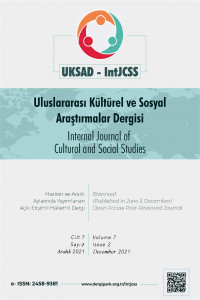Abstract
Western film türü ortaya çıktığı ABD’den tüm dünyaya yayılarak popüler olan ve hala günümüzde seyirci kitlesi bulunan bir tür olarak karşımıza çıkmaktadır. Western filmler Amerikan’ın kuruluş mitini anlatan filmler olarak bilinmektedir. Kapalı bir evrende geçen bu filmlerde beyaz erkek kovboy, belirli ırklara karşı şiddet kullanarak düzeni sağlamaktadır.
Bu çalışma, bir western türü örneği olan Hızlı ve Ölü (1995, Sam Raimi) filmini Will Wright’ın klasik western olay dizilimine göre incelemektedir. Bu film, klasik western filmlerinde görmeye alışık olunmayan kadın kovboy karakter ile dikkat çekmektedir. Film seçiminde kadın kovboy karakteri etkili olarak filmi post-westerne yakınlaştırsa da Hızlı ve Ölü filmi gerek Amerikan ideolojisini yansıtan tematik görenekler gerekse Wright’ın klasik western olay örgüsünü temel almaktadır. Çalışmanın amacı, Will Wright’ın geliştirmiş olduğu Klasik Western olay örgüsü dizilimi temel alınarak, film içerisinde kadın kovboyun varlığı, eylemleri ve diyalogları üzerinden post-western dünyasında kadın imgesine bakmaktır. Çalışma sonucunda, kadın kovboyun kasabaya girişi ve kasabada saygınlık kazanması, sonrasında kasabaya düzen getirmesi süreçlerinde öne çıkan bir kadın karakter olsa da filmin alt metninde bunun erkeklerin gücü ile olabileceği fikri açığa çıkmıştır.
References
- Abisel, N. (1995). Popüler sinema ve türler. İstanbul: Alan Yayıncılık.
- Campbell, N. (1957). Post-westerns: Cinema, Region, West. London: University Nebraska Press.
- Deleuze, G. (2021). Sinema-I: hareket imge. (Çev. Soner Özdemir). İstanbul: Norgunk Yayıncılık.
- Donen, J-Markey, P.-Shapiro, A. (Yapımcı)&Raimi, S. (Yönetmen). (1995). Hızlı ve Ölü (Sinema Filmi). ABD: Sony Pictures Entertainment.
- Gönen, M. (2008). Western ve amerika: bir ulus uygarlık kurgusu. İstanbul: Versus Yayınları.
- Harvey, L., [1990] 2011, Critical Social Research, available at qualityresearchinternational.com/csr, last updated 9 May, 2011, originally published in London by Unwin Hyman.
- Ryan, K., Kellner, D. (2010). Politik kamera: çağdaş hollywood sinemasının ideolojisi ve politikası. (Çev: E. Özsayar). İstanbul: Ayrıntı Yayınları.
- Sowers, D. (2017). Genre, the postmodern, and american western cinema: a study of the films of clint eastwood, quentin tarantino, and joel and ethan coe. thesis final draft. The University of Texas at Austin.
- Ünal, Y. (2008). Dram sanatı ve sinema: anlatım olanakları ve sınırlılıkları. İstanbul: Hayalet Kitap.
- Wright, W. (1975). Sixguns and society: a structural study of the western. London: University of California Press.
Abstract
Western movie is a genre that has firstly emerged in America and became very popular in the world and has still been watched by the audience today. Western films are known as films that tell the founding myths of the American nation. In these films, which take place in a closed universe, the white male cowboy maintains order by using violence against certain races. This study analyses Fast and the Dead (1995, Sam Raimi), an example of a Western movie in the light of Will Wright's classical narrative structure of the Western. What makes this movie distinctive is the female cowboy character we have rarely come across in traditional Western films. Although cowgirl character is a salient feature of Post-western movies, Fast and the Dead is based on both the thematic traditions of American ideology and Wright's classical Western plot. The study aims to scrutinise the image of the woman in the post-western world through the existence, actions, and dialogues of the female cowboy within the framework of the Classic Western plot sequence developed by Will Wright. This study shows that even though woman cowboy is the central figure who gains the respect of the people in the town after her arrival and then brings order there, all of these can be achieved by the help of male power in the subtext of the film.
Keywords
References
- Abisel, N. (1995). Popüler sinema ve türler. İstanbul: Alan Yayıncılık.
- Campbell, N. (1957). Post-westerns: Cinema, Region, West. London: University Nebraska Press.
- Deleuze, G. (2021). Sinema-I: hareket imge. (Çev. Soner Özdemir). İstanbul: Norgunk Yayıncılık.
- Donen, J-Markey, P.-Shapiro, A. (Yapımcı)&Raimi, S. (Yönetmen). (1995). Hızlı ve Ölü (Sinema Filmi). ABD: Sony Pictures Entertainment.
- Gönen, M. (2008). Western ve amerika: bir ulus uygarlık kurgusu. İstanbul: Versus Yayınları.
- Harvey, L., [1990] 2011, Critical Social Research, available at qualityresearchinternational.com/csr, last updated 9 May, 2011, originally published in London by Unwin Hyman.
- Ryan, K., Kellner, D. (2010). Politik kamera: çağdaş hollywood sinemasının ideolojisi ve politikası. (Çev: E. Özsayar). İstanbul: Ayrıntı Yayınları.
- Sowers, D. (2017). Genre, the postmodern, and american western cinema: a study of the films of clint eastwood, quentin tarantino, and joel and ethan coe. thesis final draft. The University of Texas at Austin.
- Ünal, Y. (2008). Dram sanatı ve sinema: anlatım olanakları ve sınırlılıkları. İstanbul: Hayalet Kitap.
- Wright, W. (1975). Sixguns and society: a structural study of the western. London: University of California Press.
Details
| Primary Language | Turkish |
|---|---|
| Subjects | Communication and Media Studies |
| Journal Section | Research |
| Authors | |
| Publication Date | December 31, 2021 |
| Submission Date | October 11, 2021 |
| Acceptance Date | November 11, 2021 |
| Published in Issue | Year 2021 Volume: 7 Issue: 2 |
International Journal of Cultural and Social Studies

